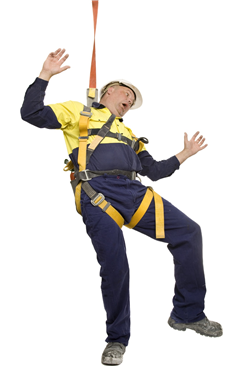
If you work at height, you'll know that taking safety seriously is an important priority. Working at height is the leading cause of injuries and fatalities in the construction industry, and this is no surprise with workers commonly working on rooftops, ladders, and fragile surfaces.
The HSE (Health and Safety Executive) are fully aware of the risks involved with such tasks and have stated working at height regulations that must be adhered to for safety when working at height.
In this blog we will aim to answer some commonly asked questions surrounding working at height, including;
- What is working at height?
- What responsibilities do employers have when working at height?
- What responsibilities do employees have when working at height?
- How to comply with working at height regulations
- How to carry out a working at height risk assessment
Working at Height Regulations - Employers and Employees:
The key responsibilities of both employers overseeing employees working at height and the employees working at height themselves include:
- Avoid setting jobs that involve working at a dangerous height when possible
- Do what you can to minimise the distance and consequences of a fall
- Use equipment which prevents falls (such as harnesses especially for working at height!)
- Ensure that employees are instructed and trained to work at height
- Ensure the work is planned, organised and supervised at all times
- Make sure that the risks from fragile surfaces have been properly controlled
- Take weather conditions into account each time working at height needs to be done
- Check that all equipment for working at height is checked and inspected
- Check the place where working at height take will take place is safe
- Take care to take any precautions that minimise the risk of falling objects
These regulations are not only to help individuals understand what they can do to help protect themselves, but also to alert employers to the responsibilities they have for employees who are working at height.
This working at height guide should help explain the official UK working at height regulations and responsibilities, whether you're an employer looking to take the necessary steps or an employee who wants to know their rights are being followed.
Definition of working at height
So, what exactly is working at height? Let's define.
In 2005, 'working at height' was defined as being at least 2 metres above ground. This criterion has since been removed, and there is no longer a minimum height for which working at height considerations apply. 'Working at height' now refers to any place where, if there are no precautions in place, a person could potentially fall and injure themselves - this is the case even if the drop is below ground level. Common examples of working at height involve work that is carried out upon roofs, scaffolding, or on ladders.
The HSE define 'working at height' as:
"work in any place where, if there were no precautions in place, a person could fall a distance liable to cause personal injury (for example a fall through a fragile roof)"
This does not include going up and down on permanent staircases in a building, or trips and falls on one level. A fall from height must involve falling from one level to another level.
How to comply with working at height regulations
There are a number of regulations that apply to working at height, many of which concern how an employer is responsible (to a reasonable extent) for their employee's safety when working at height. If you control any work that will take place at height, as a building manager or facility co-ordinator, you must ensure the following things:
- Avoid setting jobs that involve working at a dangerous height when possible
- Do what you can to minimise the distance and consequences of a fall
- Use equipment which prevents falls
Employers who are planning the work must be sure to:
- Ensure that employees are instructed and trained to work at height
- Ensure the work is planned, organised and supervised at all times
- Control and assess the risk of injury
- Take weather conditions into account each time working at height needs to be done
- Check that all equipment for working at height is checked and inspected
- Check the place where working at height take will take place is safe
- Take precautions that minimise the risk of falling objects
What must employees do to appropriately follow working at height regulations?
Of course, employers can't control everything - there is a level of responsibility the employee has to ensure their own safety. Not every instance can be controlled by the employer, particularly how their employee will behave whilst carrying out work at height. For that reason, employees must ensure that:
- They comply with the Working at Height Regulations
- They are not under the influence of any intoxicant which could lead them to become a danger to themselves or others at work
- They use the working at height equipment or tools they have access to which prevents falls or accidents
- They wear appropriate PPE
- They report any known dangers in the workplace such as defective equipment that may become a health and safety risk
- They behave in a responsible manner to protect the health and safety of themselves and others
- They utilise the working at height safety training provided by the employer
Working at height training
What training could my employer provide for working at height? Training courses can help both the employer and employee ensure they know of all the proper precautions that could keep everyone working at height safe. Two of the courses you could consider are:
General Working at Height Training - Learn the essential knowledge anyone working at height should be aware of. Understand the regulations and understand the best ways to minimise risks.
Safety Harness & Lanyard Training - Learn the correct harness and lanyard for each situation to make sure the proper equipment is being used. Important for employers and employees to know so they can ensure they are properly prepared for working at height.
How to carry out a working at height risk assessment
Regulations state that a risk assessment must be carried out before any working at height takes place. This a full examination of the factors that could cause harm in the workplace so that the correct precautions can be carried out. This is to ensure all risks have been determined so they can be reduced or eliminated. Take a read of this blog to find out what's involved when planning a working at height plan.
A competent working at height risk assessment will involve:
- Identifying the potential hazards
- Identifying who may be harmed and how
- Evaluate all known potential risks
- A detailed record of all the potential hazards
It is illegal to work at height until a risk assessment has been carried out. It is only following this assessment that an employer can review and update how they have taken steps to minimise or reduce these risks.
How do you plan a working at height rescue plan?
Even if you have taken all the necessary precautions that are legally required and have adhered to all working at height regulations, it's impossible to account for every possibility. This is why it is so important that a working at height rescue plan is in place in case of an accident or injury.
The HSE regulations ensures that this is taken to account by the employer and that employees are aware of it. Those who are expected to carry out the rescue plan must be suitably trained for such procedures and this rescue plan must be updated frequently to ensure any equipment that may be required is checked or updated.
Each rescue plan should ensure that a working at height kit is always near in case of any incident. If you need to get a rescue kit for your project you can browse our Emergency Rescue Kits here.
If you are creating a working at height rescue plan you must consider:
- What is the anchor point for all safety equipment?
- Will the rescuers be putting themselves in danger when carrying out the plan?
- How will the rescuers move those in need once they are reached?
- Is the safety equipment the individual was using still intact/safe?
- How will the individual be attached to the rescue kit?

What equipment should be provided to employees working at height?
There is a wide range of equipment that can help prevent an individual from getting injured whilst working at height. We make it our business to supply the equipment that is needed in this working condition. Take a look at our full range of working at height safety equipment, or see our list below of vital equipment we recommend you think about when preparing your team to work at height:
Harnesses Height Safety Kits Fall Protection Equipment
If you would like any advice on what equipment best suits your working at height plan, feel free to get in touch. We are more than happy to ensure you know what equipment is needed to follow correct work at height regulations and fulfil employer responsibilities. For any query regarding and safety or lifting gear (or both!) contact us today.
Read More: What Does 'What Does ‘Working at Height’ Mean?

